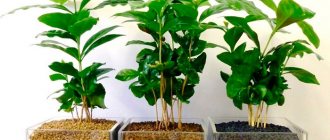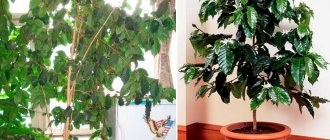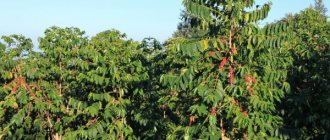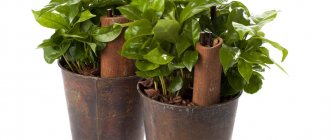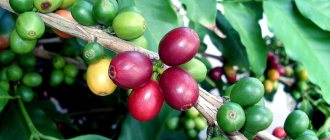Indoor trees are very popular in modern decorative floristry.
Compared to regular flowers, they require significantly less care. At the same time, a small tree looks impressive in almost any room. Dear readers!
For you, we have created communities on social networks in which useful articles and interesting ideas are published several times a day! Subscribe and receive useful content in a convenient format! In today's article we will talk about one of the most popular indoor woody plants, the coffee tree.
Botanical description and homeland of the plant
The plant is part of the Rubiaceae family. The tree's homeland is ancient Abyssinia (modern Ethiopia). Now the coffee tree can be found even in the wild in South America, Asia, and other areas of Africa.
Indoor varieties are widespread everywhere.
At home, coffee is a low bushy tree that grows mainly in several thin trunks. The plant does not branch much. The process of formation of additional shoots usually begins only in the 2nd year. Coffee has large oval leaves with a pointed tip. The surface of the leaf blade is slightly convex with clearly visible veins. The color is green.
Coffee blossoms and bears fruit. The inflorescence is umbellate and consists of small white flowers. After flowering, a fruit is formed, which turns red when ripe. The berry is covered with a small crust, inside there is sweet and sour pulp and a couple of seeds-grains, from which the famous drink is prepared.
Types of coffee trees
Below we will describe those varieties of coffee trees that are most popular in indoor cultivation.
Arabian coffee tree (Coffea Arabica)
This variety is popularly known as Arabica. In the wild, the bush reaches six meters in height. In indoor culture, its dwarf variety “Nana” is grown, the height of the bush does not exceed 0.8 m. Flowering is observed twice a year. The bush can be easily shaped.
Congolese coffee tree, or Robusta (Coffea canephora)
The variety is unpretentious and has a well-developed root system. A characteristic feature of this variety: after the fruit branches die naturally, they fly away.
Liberian coffee tree (Coffea liberica)
This tall and fairly large shrub has a pyramidal-shaped crown. It can be grown both in a spacious room and in a greenhouse. The variety is highly resistant to most diseases of coffee trees.
Caring for your coffee tree after purchase
Before you go to the store and buy yourself a new green pet, you should think about where to put it. Remember that coffee is a tree, and although it will not grow to several meters at home, it still needs space.
So, you bought yourself a coffee seedling. First of all, he must be quarantined. This is necessary so that the plant gets used to the new conditions. Also during this time you can find out whether the plant is sick and whether pests live on it.
In addition to quarantine, the coffee tree can be replanted. A transplant is required in the following cases:
- Several coffee cuttings sit in one container;
- The pot is too low quality;
- The soil mixture is a nutrient substrate, not ordinary soil.
ON A NOTE. Don't worry if all the leaves have fallen off the tree after replanting. This is due to the fact that all the plants in stores are “overfed”. Very soon the coffee will return to normal.
When can we expect the harvest?
When germinating a tree from grains, the first fruits will appear no earlier than four years later. A tree grown from a cutting provides fruiting already in the first year of flowering.
If you follow all the specified rules for caring for coffee, you can get not only a source of delicious drink, but also a decoration for your apartment. From grains you can create all kinds of decorative elements.
Coffee is believed to help combat migraines and fatigue. Used to dilate blood vessels and increase blood pressure. It is occasionally used for poisoning.
It is worth noting that according to the rules of Feng Shui, this tree has a number of unique properties. It is believed that when placed in a home, well-being and family relationships improve. This plant is recognized as one of the types of money tree.
When placing this tree in the bedroom, a long and strong family life is guaranteed. This plant attracts positive energy into the house, which is already a reason to start growing a coffee tree.
Growing conditions
In general, the coffee tree does not pose impossible tasks for the grower. The plant needs quite ordinary care and growing conditions, but with its own characteristics.
Temperature
Coffee loves warmth, but does not handle heat very well. The ideal temperature is 23 – 25 degrees. In winter, you can slightly reduce the temperature, but only to 15 degrees. If the temperature drops further, the coffee may shed its leaves.
IMPORTANT! Protect the tree from sudden changes in ambient temperature and drafts. Both have a negative effect on flowering and fruiting.
Air humidity
Coffee prefers high air humidity. In a dry climate, the tree does not feel well, often gets sick, and blooms poorly.
Additionally, it is recommended to spray the plant with a spray bottle. In the summer, you can periodically “bathe” the coffee tree.
IMPORTANT! In winter, the tree tub should be placed away from radiators, as the tips of the leaves will begin to wither due to dry air.
Coffee also loves fresh air, so we recommend periodic ventilation in winter. The main thing is to make sure that there is no draft, as this can make the plant sick.
Coffee tree after spraying
Lighting
The coffee tree comes from Africa, which means it loves light. But it is still undesirable to expose it to direct sunlight. It would be ideal to shade the plant a little. To do this, you can cover the windows with paper, use tulle or Roman blinds.
ON A NOTE. If your apartment does not have the right place with sufficient lighting, then the coffee tree can be placed under fluorescent lamps.
The soil
For a coffee tree, it is better to choose acidic soil (with a pH level less than 7). If you prepare the soil yourself, then follow these proportions: 2 parts acidic peat, 1 part distilled, 1 part sand, 1 part each leaf and greenhouse soil.
Pot
It is equally important to choose the right pot. In a container that is too small, the plant will be cramped. The roots will quickly fill the entire volume, and the coffee will begin to hurt. If it is too large, on the contrary, the tree will not be able to receive all the nutrients when watering and feeding.
It follows from this that you need to choose a medium-sized pot for the plant, so that it is not cramped, but there is space to grow.
In what cases is support needed?
Sometimes your green pet may need support. These are mainly cases when the plant has too thin shoots, as well as after transplanting into a new pot, when the tree has not yet taken root.
Choosing a place to put it
Indoors, the coffee tree is best placed near a south window. If this is not possible, then place the tree on the east or west window.
It is not recommended to place the pot in dark corners or in the back of the room. Lack of lighting negatively affects the decorative qualities of the plant.
In late spring and summer, the coffee tub can be moved to the loggia or taken out to the terrace. The tree will really like this, as it will be provided with a sufficient amount of light and fresh air.
What does it look like in the interior?
The coffee tree is not just another flower in a pot. This is part of the interior decor of any room. The plant looks beautiful in a modern studio apartment, office, and bedroom. The coffee tree is also great for decorating public spaces: cafes, reception areas, corridors, conservatories, etc.
A little about coffee trees
The coffee tree is a plant up to 5-8 meters, but in everyday life its height can be easily controlled by regular pruning - usually up to 2 meters. The leaves are dark green, slightly ribbed, shiny and beautiful. In its subtropical conditions, Arabica flowers bloom twice a year, and many achieve the same at home. In cold climates it can bloom in spring and summer.
Small white flowers are similar to jasmine, with a rather bright aroma; flowering begins at about 2-3 years. Then the fruits appear, at first they are green, eventually turning red. You don’t have to take them off right away, you won’t miss a moment - they can remain on the branches for 2 months without deteriorating, only slightly drying out.
The optimal temperature is from +10 to +25 degrees, possibly from +5 to +30. But frequent temperature fluctuations can cause leaves to drop.
Flowering conditions
The coffee tree blooms in spring. It forms umbrella-shaped inflorescences consisting of small white flowers. At the same time, the tree emits a pleasant aroma.
REFERENCE. The coffee tree fades very quickly. Don't miss this amazing moment!
You can also help the plant bloom. To do this, gently shake the branches on which the inflorescences appeared. Another way is to take a cotton swab or soft brush and touch the flowers. This will cause artificial pollination.
After flowering, fruits begin to set. They ripen almost throughout the spring-summer period, and in some cases the process can even take 1.5 – 2 years.
IMPORTANT! In order for coffee to bloom bright and memorable, it needs to be allowed to rest in winter. During the dormant period, you will have to reduce watering and eliminate the application of fertilizers. You also need to slightly reduce the temperature.
Brief description of cultivation
- Temperature . In the spring-summer period - from 20 to 30 degrees, and in winter - from 12 to 15 degrees.
- Air humidity . Should be increased (approximately 70 percent).
- Illumination . Supplementary lighting or diffused sunlight. The best option for the plant is a western or northern window sill.
- Watering . The substrate is moistened with well-settled softened water. In the warm season, watering is carried out once every couple of days (at least), and in the winter months - after the top layer of the soil mixture has dried.
- Substrate . Should be slightly acidic. A high-quality drainage layer is made at the bottom of the pot.
- Fertilizer . Fertilizing with organic fertilizer is carried out once every 15 days. At the same time, mineral fertilizers are added to the substrate once every 2 weeks.
- Transplant . It is carried out only when the roots no longer fit into the pot (approximately once every 3 years).
- Reproduction . Seed and vegetative methods.
- Features of care . The plant reacts extremely negatively to even a small draft and stagnation of moisture in the roots. In winter, the bush needs rest, and it is removed away from operating heating devices.
Coffee tree: how to properly care for and replant
Transfer
While the coffee tree is young, it is replanted every year. Upon reaching the age of three, the growth of the tree slows down. Accordingly, the frequency of transfers is reduced. It will need to be carried out approximately once every four years.
Replanting a plant is no different from a similar process carried out with other indoor flowers. On the contrary, replanting a coffee tree is even easier, since it has stronger roots.
Saplings
ON A NOTE! But this does not mean that you need to work sloppy. Still, try not to damage the root system.
- First of all, prepare a pot of suitable size, proper soil and drainage.
- First, place the drainage in a new container.
- Then remove the plant from the old pot. This must be done using the transshipment method.
- If old drainage is stuck to the bottom, carefully shake it off.
- Carefully remove the old soil.
- If you want to plant the cuttings in different pots, then place the entire plant in a bowl of warm water and carefully wash off the remaining soil. Next, carefully separate the tangled roots of each stem.
- Sprinkle the drainage in the new pot with soil and place the seedling there.
- Carefully add soil to the desired level and water the transplanted plant.
IMPORTANT! If you are not replanting, then change the top layer of soil. This is necessary so that the earth does not become depleted.
Problems of growth and development of the coffee tree
The coffee tree, like any other indoor plant, is susceptible to various diseases and pest attacks. In addition, problems with growing plants are often associated with improper care:
The tips of the leaves turn yellow and dry . This means that the indoor air is too dry. The same symptoms occur with a lack of iron.
Dry blackish spots on leaves . Another symptom of lack of moisture. Perhaps the plant is not sprayed sufficiently.
The appearance of dark brown spots on the leaves . Indicates root rot due to overwatering.
The lower leaves turn yellow and fall off . A small amount indicates the natural aging process of the coffee tree. If there are more yellowed leaves, this may be a sign of starvation of the plant.
Brown spots on leaves . This is a lack of nitrogen.
Purple spots . Indicates phosphorus deficiency.
Helpful information
Daria Vorontsova
Amateur gardener. He is interested in growing various greens at home.
When the first signs of nutrient deficiency appear, you need to immediately make up for this deficiency.
What causes it and how to treat it
The most common diseases of the coffee tree are sooty fungus, coffee rust, bean borer and others. Some of them (fungus) appear due to heavy watering, which provokes the appearance of rot and mold. Others are spread by various pests.
Pests
Most often, the coffee tree is attacked:
Shchitovka
Spider mite
Mealybug
You can get rid of insects using special insecticides. Fitoverm and Aktara are safe for plants. The selected drug is diluted according to the manufacturer's instructions and watered 2-3 times with an interval of 10 days.
Fertilizers
The coffee tree needs constant feeding, especially during its growth. If the fertilizer is selected correctly, the development of the bush will be complete. This will ensure thick, dense foliage and abundant fruiting. Typically, fertilizing is applied during flowering and fruit formation. In winter, the coffee tree is not fertilized.
Experts recommend following the following feeding schedule:
- March−May. Nitrogen-containing compounds are used to stimulate plant growth. Then mineral and organic fertilizers are applied.
- Summer. At this time of year, it is enough to apply fertilizer once every 1.5-2 weeks. Organic fertilizers are not used (potassium phosphate is sufficient).
- September. In autumn, potassium compounds are suitable as fertilizers. They are necessary for the plant to prepare for winter.
Helpful information
Daria Vorontsova
Amateur gardener. He is interested in growing various greens at home.
To feed the coffee tree, acidified water is often used (take 1 g of citric acid per 1 liter of water). The plant is watered with it no more than once a month.
Reproduction
Coffee is propagated by seeds or vegetatively. Below we will talk about each method in a little more detail.
Propagating a coffee tree from seeds
If you are an experienced gardener, you can try to grow a coffee tree from an ordinary coffee bean.
Fruit
REFERENCE. Roasted grains will not work.
First of all, it is necessary to destroy the “shell” on the grain. To do this, you can carefully file it or soak it in a solution of hydrochloric acid. We recommend making careful cuts, as the use of chemicals can damage the seed itself.
Next, the seeds are washed with potassium permanganate and placed in a solution of a growth stimulator. Any will do.
You need loose soil, consisting of turf soil, sand, ash and peat. The seeds are placed in the soil and pressed down slightly. Then the plantings are watered and covered with film, a transparent plastic lid or a plastic bag. This is how we create a greenhouse effect inside.
There is no need to place the pot directly in the sun, but it should not be placed in the shade either. A warm place near the windowsill is best.
The seeds will germinate in about a month.
The first transplant is carried out when foliage appears.
How to propagate vegetatively
The vegetative method is the most effective and requires much less labor.
- First of all, prepare the cuttings. They should be about 8 – 10 cm long and have at least 2 buds.
- Then place the cuttings in containers and keep them warm.
- To make rooting go better, put a plastic bag on top or cover it with a jar. This will create a greenhouse effect.
- Periodically water the soil and ventilate the seedlings.
- Once the plants have taken root, they should be transplanted into permanent pots.
Propagation by cuttings
How to grow an indoor coffee tree from beans at home?
Store-bought grains are not suitable for planting because they are dried so that they can be stored for a long time. Germination is lost during this treatment. For a gardener who wanted to do just this, problems begin: “Where can I get coffee beans?” You can try looking for planting material on the websites of flower shops on the Internet, or go to forums in search of like-minded people who are ready to share coffee beans.
Coffee beans.
The grain was found with great difficulty. Now, based on the opinion of professional gardeners, for whom growing coffee at home has already become commonplace, you can get down to business:
- First of all, you need to destroy the hard shell of the coffee bean. This can be done using a small nail file, knife, or file.
- Next, soak the grain in a growth stimulator (any flower shop will have a sufficient amount of such preparations).
- While the grain is swelling, you should start preparing the soil. The plant requires a loose soil mixture, which can also be picked up in the store.
- All that remains is to simply plant the grain in a flowerpot and cover it with a fairly thick layer of soil (about five centimeters).
Grain planted at home requires patient care and maintenance of the plant sprouts in certain conditions, in particular, the soil must be constantly moist, but not wet (wet is considered to be soil that turns into a lump). The room temperature should not drop below twenty degrees, otherwise it will not be possible to grow a home coffee tree from seeds. An adult perennial coffee tree needs the same temperature, and in winter it should not fall beyond twelve degrees, of course, “plus”.
How to form a crown
The coffee tree itself is highly decorative. Its shoots are weakly branched, and large beautiful leaves form a beautiful crown. In general, coffee does not require decorative pruning.
However, it all depends on the specific instance. It is necessary to regularly trim dried shoots, and it is also a good idea to remove too long branches. The fact is that they will take away the energy that the plant needs to bloom. It is better to carry out the operation in late winter - early spring.
If you doubt whether your green pet needs pruning, then it is better not to do it.
What does coffee look like?
Arabica coffee (coffea arabica) is a perennial shrub or compact tree belonging to the Rubiaceae family. Its homeland is Africa and Asia, but it is grown under cultural and domestic conditions in many countries. The tree can reach a height of 1.5 m. Coffee has a thick, lush crown, rich green leaves, oblong-pointed, up to 15 cm long. They are located oppositely on flexible, slightly branching shoots. The surface of the leaves is glossy, with well-defined veins. The root system of the Arabica coffee plant is branched, with a long central root.
Flowers and fruits are especially decorative. The flowers of the coffee tree are star-shaped, reminiscent of jasmine, the petals are white, with a strong pleasant aroma, collected in inflorescences of 3-6 pieces. The buds begin to bloom in the spring. The plant fades quickly, after 1-2 days. After six months, fruits are formed in their place, shaped like oblong cherries. They are usually red or black. Each cherry contains 2 coffee beans.
Rejuvenation
Unfortunately, about 10 years after planting, coffee begins to age. The decorative value of the plant decreases. The leaves become yellowish and limp. So, it's time to rejuvenate.
To do this, cut the stems. The procedure must be carried out with a sharp instrument so that the cuts are neat and even. Do not break the shoots under any circumstances! Even if the tree survives, it will finally lose its decorative effect and become ugly.
Don't forget to treat the cut areas with crushed activated carbon.
ON A NOTE. By the way, cuttings are taken from the cut branches for propagation.
Harvesting
By carefully caring for your tree, protecting it from pests and diseases, in 4-5.5 years you will be able to collect your first coffee harvest. Having noticed that flowers have appeared on the tree, it is recommended to have time to lather them. After all, their beauty is short-lived.
After 10 days, the flowers will be replaced by berries. They will ripen for about six months. Each of them contains only 2 coffee beans. The collection is done, just like the coffee beans are extracted, only by hand. Ripe berries, after being picked for about 30 days, are first dried in the sun, then they are dried in a dry black room for another month. Afterwards, you need to peel off the dried berry pulp and extract the coffee beans.
Growing a coffee tree at home is not difficult. But, like any plant, it requires attention and some care. With proper organization of its maintenance, you can become not only the owner of a lush, beautiful bush. Once collected, you will be able to prepare the most delicious coffee, grown on your home coffee plantation.
We hope that this article was useful to you, we would be grateful if you share it with your friends on social media. networks. Have a nice day and see you again!
Watering
Coffee is a water-drinker. In the spring-summer period, you need to water abundantly and often (every 2 - 3 days). But do not allow the soil in the pot to become waterlogged. Loosen the soil regularly to prevent it from clogging.
During the dormant period, watering should be reduced to once a week. In winter, simply do not allow the soil to dry out and maintain the general level of humidity.
For irrigation you need to use soft, settled water. If you have such an opportunity, water with rain or snow water. But do not forget that the liquid should be at least room temperature, and preferably a couple of degrees warmer. Cold water can cause shock to the roots, which can lead to all sorts of troubles.
Soil and fertilizing
Only acidic soil is suitable for coffee; in neutral soil the plant will wither and become sick. To make the best earthen mixture, you need the following components:
- sour peat - 2 parts,
- leaf soil - 1 part,
- humus – 1 part,
- coarse sand - 1 part.
During the period of active growth (April-October), the coffee tree needs feeding. Every two weeks the plant is fed with a comprehensive formula containing nitrogen and potassium. Watery fertilizers are ideal for azaleas, but granular fertilizers can also be used. For example, dissolve 10 g of ammonium nitrate and 6 g of potassium salt in 2 liters of water.
Fertilize coffee only after one more watering - you cannot pour fertilizer into dry soil, otherwise the roots may get burned. Proponents of organic fertilizers can add dried mullein to the pot.
Popular varieties
Coffee is not the most numerous genus of plants. There are only a few dozen species. The following plant varieties are most often grown indoors.
Arabica (Arabian coffee)
It is a low tree with oval leaves. The leaf blades have an olive tint. The flowers are very small. The fruits are burgundy.
Arabica is the most popular variety of coffee to grow indoors.
Nana (Dwarf coffee)
A very beautiful small tree (up to 80 cm) with glossy leaves. Unlike other varieties of coffee, it bears fruit very well in an apartment. Has high decorative value. Loves being sprayed.
Liberian coffee
A tree with a thin trunk and large (30-40 cm) leaves. Unlike other varieties, Liberian coffee has leaf plates that are more rounded towards the end. Fruits abundantly. The berries are yellowish-red. It lends itself well to pruning and crown shaping.
How to plant correctly
This plant should be protected from sudden temperature changes and exposure to drafts. With proper care, the crop will bloom and bear fruit profusely.
Selection of capacity
The crop should be planted in a tall pot.
A high-quality drainage layer is of no small importance. The roots of the culture grow downwards
Soil requirements
The tree should be grown in a loose and acidic substrate. It is best to mix coarse sand, crushed coal, humus, and peat. These components are taken in equal parts.
Planting scheme
It is best to grow a crop from a grain. It should not be fried. To plant a plant, do the following:
- Soak the grain in a solution of hydrochloric acid or lightly saw it.
- Place the grain in a growth stimulator.
- Moisten and loosen the soil. Plant a seed. It should not be deepened too much.
- Place the pot in a lighted place. The temperature should be more than +20 degrees.
Diseases and pests
The most dangerous pests for coffee are:
- Spider mite. If an insect is detected, the plant must be immediately treated with Aktara or Karbofos.
- Shield. To get rid of this pest, the plant is first treated with soapy water and then with insecticides (for example, Karbofos).
- Aphid. They fight it in the same way as with scale insects. This pest can still be removed using regular alcohol. Dampen a cotton pad and wipe the infected leaves and shoots with it.
The most common diseases are Coffee Rust, Gommosis and Sooty Fungus . Diseases manifest themselves in different ways, but most often the leaves are affected. They become covered with brown spots and streaks, or have a black edge.
For fungal diseases, it is better to immediately use fungicides. The fungus is usually very tenacious, and traditional methods may not help. Fitosporin and copper sulfate are effective. It is also necessary to remove the affected parts of the plants to prevent the spread of the disease.
IMPORTANT! Regular preventive inspection of the plant will protect it from 99% of diseases and pests. It is always much easier to prevent a disease than to try to cure it.
Pests
Scale insects, aphids, mealybugs and spider mites are not harmless neighbors. However, the appearance of parasites in a flower corner should not cause panic. There is no need to throw away a flower with infested bugs. Carefully examine the leaves of the plant. Curling, drying out and spots on the leaves of the plant are a sign of a painful condition of the tree.
Proper care will help prevent the proliferation of pests.
Scale insects are a common pest, distinguishable by the shape of the shield. This is a flat growth, often brown in color. Scale insects harm the plant. The leaves lose their healthy appearance and dry out quickly. In some cases, the coffee tree dies due to lack of oxygen and moisture. A harmless insect drinks the juice of the plant.
• If small yellow spots appear, soak a swab in alcohol and gently scrub all the leaves.
• A solution of alcohol and soap will help to completely treat the wood. Use a spray bottle to spray the entire bush. A timely procedure will prevent damage to the fruits of an adult plant.
• Before spraying, pay attention to the condition of the leaves. It is advisable to wet the thinned plates with a soft cloth or brush. The solution should not contain a lot of alcohol.
15 gr. soap, 10 ml of denatured alcohol or vodka and warm boiled water.
Repeat the procedure no more than 2 times a week until the leaves recover.
How to resuscitate?
If your coffee tree is sick, you can try to save it. Depending on the condition of the plant, there are two effective methods:
- Transfer;
- Rooting cuttings.
If you have “flooded” a flower, you can save it by replanting it in a new pot. To do this, be sure to clean the roots from the old soil, treat them with potassium permanganate, sprinkle with activated carbon and carry out the procedure itself.
Please note that old soil cannot be used.
If the transplant does not help and the plant continues to wither, then the only chance is to cut healthy cuttings and root them. Alas, the old plant cannot be saved.
General cultivation features
If you start an Arabica coffee tree, you need to allocate a separate place for it on the windowsill, since it does not tolerate the presence of other plants. Arabica will not bloom or bear fruit.
Tropical plants do not like sudden temperature changes. Throughout the year the thermometer shows from 19 to 26 degrees. This is one of the reasons to plant Arabica on your windowsill - the climate of the apartment is well suited for the capricious plant.
The coffee tree responds very well to fertilizing. In nature, for example, in Ethiopia, Arabica grows on volcanic soils with weak acidity. This is nutrient-rich soil, so fertilizers are not used there. In the apartment you will have to use both organic and mineral complex mixtures. The coffee tree loves soil rich in humus.
The Arabica bush does not tolerate being moved, even if they want better lighting. During budding, the tree may shed its flowers. This is one of the conditions for obtaining a harvest. You should immediately place it on the south or east side and not move it any longer.
Interesting! If you still need to move the tree to another room, then cover it with gauze in one layer and leave it for a week. Then they move it to another place, but the gauze is not removed for another week. In this way, it is possible to deceive the plant, which for two weeks receives only diffused light and gets used to the new conditions.
It is advisable that there are no heating radiators nearby that dry out the air. The second condition is the humidity of the air and the earthen coma. The soil should never dry out completely. In nature, Arabica trees bloom after each rainy season, when the water washes away the nutrients so the plants can absorb them in the liquid.
Anyone who has grown Arabica coffee at home has tried all the methods. There are only two of them - plant freshly harvested grains in the ground or root a cut cutting. Each method has its own advantages and disadvantages.
Common mistakes
The most common mistakes in plant care are, of course, overwatering or underwatering, as well as failure to comply with air humidity requirements. Accordingly, the tree will either begin to rot or will wither and dry out.
It is also worth remembering that in winter the temperature should not fall below 15 degrees. Coffee is a tropical plant that does not tolerate cold weather well. At this time, it is worth reducing watering and stopping the application of fertilizers.
The third most common mistake when growing this plant is using the wrong soil. Of course, an unsuitable soil mixture will not cause the death of the flower, but the decorative effect will decrease. For example, the leaves will turn pale.
Diseases
The main difficulty in home cultivation comes from caring for the leaves of the coffee tree.
Experienced florist G.A. Kizima in the “Encyclopedia of a Reasonably Lazy Gardener, Gardener and Florist” reveals the secrets of troubles:
• The lack of color and shine in the leaves of the plant is a consequence of low acidity of the soil.
• Yellowness and dryness at the tips of the leaves are a sign of lack of moisture and oxygen access to the room.
• The fruits never appeared - the location of the pot was often changed.
• If you find small pests, check the watering rules and lighting conditions.
Answers to popular questions
Why are my tree's leaves drying out?
This occurs due to too dry air in the room. Place saucers of water next to the pot or use an automatic humidifier. You can also put wet pebbles or other pebbles, moss, etc. in the tray.
What to do if pests appear?
First of all, the plant needs to be isolated from other flowers. Then treat with insecticides. Take your time to return the pot to its place. It is likely that you will have to process it several times.
The leaves are very pale and inconspicuous. What's happened?
As mentioned earlier, coffee loves acidic soil. Loss of decorative qualities of foliage is one of the indicators that the soil mixture is not suitable. A transplant is needed.
There are dark spots on the leaves and they fall off. What to do?
There are two reasons for this phenomenon: insufficient watering or insufficient lighting. Check the conditions of the flower. If necessary, move it and feed it.
Possible problems
If there are violations in the care of the coffee tree, problems may arise such as:
- Darkening and drying of the edges of leaf plates . The air in the room is excessively dry.
- The foliage turns yellow . The root system has rotted.
- Brown spots form on the leaf blades . Nitrogen deficiency in the substrate.
- The appearance of holes on the leaves . This occurs as a result of sunburn.
- Young foliage turns yellow, while the veins are colored green . The substrate is not acidic enough.
- The foliage turns yellow, begins to rot and flies off . Moisture regularly stagnates in the soil mixture.
- Flying leaves in winter . The shrub feels an acute lack of light.
- Excessively slow growth . Lack of nutrients in the soil mixture.
- The foliage becomes wrinkled and yellow spots form . Potassium deficiency or soil mixture is moistened with hard water.
- The leaf blades are covered with brown or purple spots . The phosphorus content in the substrate is too low.
- Young foliage is pale yellow and very small . This is how iron deficiency manifests itself.
- The most common pests that inhabit the plant are mealybugs, scale insects and spider mites.
Interesting Facts
In addition to aesthetic benefits, coffee also brings practical benefits. The tree acts as a kind of filter, cleansing the room of impurities and toxins.
There are also repeated reviews that the coffee tree has a sedative effect, calms the nerves, removes stress and fills a person with new strength.
If you want to make coffee from home-grown coffee beans, keep in mind that the drink will be much stronger than store-bought coffee. This is due to the fact that homemade coffee has a higher concentration of caffeine.
In the teachings of Feng Shui, it is believed that the presence of a coffee tree in a house helps to increase the wealth of its inhabitants.
Esotericists advise placing a tree in the bedroom, as they believe that it strengthens mutual feelings.
How to start a coffee tree at home
The best option for your home is an Arabica coffee tree. Robusta, although less fastidious, requires cross-pollination, so it is more difficult to get it to bear fruit. If you don’t have enough space in your house, you can buy dwarf Arabica beans or sprouts, one of the most popular varieties is Albert.
There are 3 ways to get a coffee tree:
- sprout from a grain;
- grow a cutting;
- buy in the store.
Growing coffee trees from beans
Ordinary green coffee beans intended for making a drink are unsuitable for germination: they have been collected too long ago and, in addition, they are subjected to special processing.
Coffee beans harvested no more than 1–1.5 months ago have the best germination. Such seeds can be purchased in online stores.
But it is best to ask the owner of the coffee tree for a ripe berry. Nature itself has covered the coffee beans with juicy pulp, so there is no need to soak them.
The optimal temperature for seed germination is from +19 to +24 °C.
Soil composition for sowing:
- 1 part peat;
- 1 part sand;
- 2 parts of turf land.
- The soil mixture must be prepared 2 weeks before sowing.
- Sowing berries:
- the soil in the pot should be moist;
- The berry is placed on its side (flat side down) in a hole approximately 1 cm deep, sprinkled with earth, which is lightly pressed;
- The pot is covered with a jar and placed in a warm, bright place (but it should not be exposed to direct sunlight).
It will take a long time for the berries to germinate, about 3–6 months. But 2 sprouts can appear from the grains at once. They are kept under glass until the cotyledon leaves shed their hard shell. Periodically, condensation is wiped off the walls of the jar. When the cotyledon leaves expand, the plant gradually begins to adapt to the drier climate of the room.
Grains freed from pulp germinate somewhat faster (after 1–3 months).
Sowing the grain:
- The seeds are soaked for 30 minutes in a very weak solution of potassium permanganate, and then for another 30 minutes in aloe juice.
- The grains are planted in the same way as berries: in a hole 1 cm deep, flat side down.
- After planting, the soil is moistened abundantly and the pot is covered with a jar.
Coffee trees grown from beans bloom in the 3rd or 4th year.
Propagation of coffee trees by cuttings
To plant cuttings, prepare a substrate in advance from peat and sand, taken in a 1:1 ratio.
Planting a cutting:
- A branch with 2 pairs of leaves is cut 2.5–3 cm below the bud. The cut should be oblique, it is treated with “Kornevin” or another rooting stimulator.
- The cuttings are vertically stuck into well-moistened soil so that the lower buds are covered with substrate.
- The cutting is covered with a plastic bag in which a small hole is cut. Periodically through this hole the cuttings are sprayed with warm water.
A rooted cutting can be replanted only after a new pair of leaves appears. Coffee trees grown from cuttings bloom in the 2nd or 3rd year.
Buying a coffee tree in a store
Coffee trees sold in stores usually look healthy in appearance: they have dark, shiny leaves and often already have flowers or berries. But it should be remembered that purchased plants are often overfed with fertilizers.
Therefore, you should not be surprised if the tree at home begins to turn yellow and shed its leaves. With normal care it will recover. The main thing is that there are no spider mites. Having brought the tree home, you need to “quarantine” it, separating it from other indoor plants. If spider mites are detected, the coffee tree must be treated with an insecticide. If the plant is healthy, it is replanted.
The benefits and harms of coffee
Coffee is a wonderful, invigorating drink. It’s wonderful to wake up in the morning and feel its enchanting aroma.
What harm is there from coffee?
The debate about whether there is more benefit or harm in coffee has been going on ever since people learned about it. Some prove that coffee excites, increases muscle tone, stimulates physical activity, clarifies thoughts, and improves mood. And this list goes on and on.
Opponents of coffee claim that it increases blood pressure and cholesterol. However, it has been proven that if you pass the brewed drink through a paper filter or napkin, coffee becomes safe. A paper filter removes kahweol and cafestol from the drink, substances that increase cholesterol levels in the blood. Whether coffee is harmful or healthy is up to everyone to decide for themselves.
Important! If you decide to brew a cup of coffee from grown beans, remember that it will be much stronger and there will be more caffeine in such a drink. As for the coffee tree in your home, we can safely say that it will only benefit you. As for the coffee tree in your home, we can safely say that it will only benefit you.
What are the benefits of coffee?
The plant cleanses the air well and saturates it with oxygen. Its beautiful appearance lifts your spirits, and by inhaling the aroma of flowers you can practice aromatherapy.
Beneficial properties of coffee beans
The homeland of the tree that produces useful fruits is the tropical region of Ethiopia. But experts have learned to grow a coffee tree with their own hands and recommend everyone who wants to start growing this tropical plant.
Many nature lovers have long been growing coffee trees at home and enjoying its magical fruits.
The perennial crop gives an annual growth of 5-10 centimeters. The coffee tree lives and bears fruit well for a very long time. Even at 100 years of age it can produce a good harvest.
Caffeine
The coffee tree and its seeds contain caffeine, an active substance that has a stimulating effect on the cardiovascular system and central nervous system. For drug or alcohol poisoning, coffee is also used.
In addition, coffee copes well with low blood pressure, headaches, “like a hand” it relieves tension, stress, fatigue, relieves depression, bad mood, adds energy, increasing performance. It is also useful because it improves brain function and blood circulation.
Caffeine is found in many medications. Caffeine charcoal is obtained from the fruit, which contains vitamins and microelements. It is used for bloating, increased gas formation and poisoning. An infusion of raw grains helps with arthritis and also reduces the level of uric acid in the body.
Medicinal properties of coffee
Drinking coffee improves the performance of the heart and respiratory organs, but you should not abuse coffee, especially for people with heart disease.
You can drink a little in case of asthenia, severe fatigue, sleepiness, fatigue, to activate mental activity.
A simple recipe will relieve headaches: raw tree grains, 1 tbsp. spoon, pour a glass of boiling water, wrap. In an hour the infusion will be ready. Drink the infusion three times a day after meals, 1/3 cup.
Esoteric properties of the coffee tree
In addition, the “green pet” has rare esoteric abilities that can influence people’s lives, bring prosperity to the family, absorb negativity in the house, extinguish aggression, and smooth out conflicts.
If a tropical exotic grows in the house, then generations of different ages begin to respect and understand each other better, and old feelings return to the spouses.
In addition to protecting the family from conflicts, exotics attract wealth to the home, promote business development and improvement in the profession, help build a career and awaken the talent of a financier.
The importance of wood for improving mood is great. The plant radiates so much positivity that people stop noticing only the bad in life, begin to feel confident, and become determined to overcome gloomy circumstances.
Humidity and watering
Accustomed to growing in mountainous areas, Arabica coffee loves good watering, and at the same time, does not like stagnation of water in the soil. The large total surface of the leaf blades leads to the fact that the plant loses a large amount of moisture every day. Coffee does not have special devices for storing water in cells (thickened stems or fleshy leaves).
You need to water your coffee in the first half of the day. The water should be at room temperature. When the temperature drops, watering is reduced, even stopping for several days. Excessive substrate moisture at low temperatures contributes to the development of fungal infections that affect the roots. Coffee loves average air humidity, but in apartments the air is usually too dry.
If there is insufficient moisture, the tips of the leaves of the plant begin to dry out. To avoid this, you can use one of the following methods: spray regularly; purchase a special device that increases air humidity in a certain area; place coffee in a group with other plants.
Selecting a soil mixture
The species of the coffee tree determines the quality of the grain drink and the possibility of growing in an artificial environment. Not all of the many varieties of coffee are suitable for indoor use.
Coffee beans are harvested from the following types of trees:
- Arabian;
- Congolese;
- Liberian;
- Excellz.
Arabica coffee is of greatest interest. The less demanding Robusta has a high yield, but is inferior to the noble Arabica in terms of taste and aroma. Rich in subtle aromas, the drink made from Arabica beans has a mild taste without excessive bitterness. Rare types of liberica and excelsa are inferior in taste to Arabian coffee and are more often found in blends.
The Arabica coffee plant is quite rare at home, but interest in this evergreen coffee bush or tree continues to persist. In a house, the crop can grow up to a meter in height - this is important to remember when choosing a planting site.
The coffee tree has long shoots and strong branches. There are many of them on the plant, they all form a beautiful lush crown. The rhizomes are unbranched, so the plant can develop freely and quickly when planted in a pot. The leaves on the crop grow oppositely. Coffee leaves are dark green and glossy, oval in shape, pointed at the end, and have obvious veins at the edges.
Fragrant, self-pollinating coffee flowers are star-shaped, white in color and form inflorescences of five. They grow in the spring in the fourth year after the plant is planted in the ground. After just six months, the plant begins to ripen fruits—coffee beans. During flowering, the plant must not be sprayed.
With proper care, you can grow a real coffee tree at home, and also get about 500 grams of a rich and pleasant drink from it in the form of small Arabica beans. With long development, the grains begin to change their color to dark red. Each fruit contains several grains.
Arabica coffee (plant mix) has a large number of varieties widely used in cultivation:
- Abyssinian;
- Bourbon;
- Mundo novo;
- Maragojil (this coffee contains a small amount of seeds, but they are large in size).
Depending on the phase of crop development, experts identify special soil compositions:
A soil mixture that is used for planting coffee sprouts and seeds. To create a substrate, leaf soil and river sand are taken, with the help of which moisture begins to quickly be absorbed into the soil mixture. Before planting a plant, it is important to sterilize the soil. The procedure is carried out by placing the seeds in a water bath, where they are left for five minutes.
When planting, the seeds are placed flat on the ground. If all the rules have been followed, then after a month and a half, seedlings will begin to appear. After waiting for the first leaves to appear on the crop, it is important to think about transplanting the young shoots into better soil, which will ensure their growth and formation. But you need to remember that transplants will have to be carried out annually until the crop is three years old. In the future, the frequency of transplants will be reduced to once every few years.
Soil that is prepared for planting an adult flower. It is created on the basis of sand, acidic peat, leaf soil, humus, moss and charcoal - all this is taken in equal proportions. In order not to search for too long for all the listed components of the substrate, they can be purchased at a special store. If a gardener wants to get an adult tree as quickly as possible, then it is best to transplant the seedling into a larger pot. Then the rhizomes will grow deeper, and the crop will receive the required amount of microelements and nutrients from the soil.
Planting a plant using the vegetative method includes preliminary preparation of a cut cutting. To do this, it is placed in a special product for several hours. It is allowed to begin planting after all the necessary material is ready. Next, the plant begins to be transplanted into the soil, into which it is deepened no deeper than three centimeters.
How to grow Arabica coffee at home. Care after purchase
So, how to grow Arabica coffee at home? The coffee tree is famous for its unpretentiousness, but this does not mean that it does not need care and the creation of the necessary conditions.
REFERENCE! The first thing you should think about before purchasing is whether your apartment has the space needed for the tree. The fact is that Arabica can grow to the size of a two-meter bush.
Position the plant so that the sun's rays do not directly hit the leaves. Contact with sunlight can cause burns on tender leaves. At the same time, Arabica loves bright lighting, preferably a little diffused.
If there is a lack of natural light, you can install phytolamps. This will create additional lighting. Coffee will feel most comfortable on windows facing east or west.
ATTENTION! Arabica is native to the tropical lands of Asia and Africa. It is there that this species grows wild.
The climate in Russia is unsuitable for coffee, so attempts to create a plantation on your own estate will not achieve the expected result. Arabica will not survive the cold season.
Watering
The active period occurs in the warm part of the year, from approximately March to October. At this time, Arabica needs the soil to constantly maintain moisture and not dry out. During hibernation, water consumption decreases.
It is better to pre-settle water for irrigation or use filtered purified water.
REFERENCE! In an effort to maintain soil moisture, you cannot overdo it and create an artificial swamp. If you overdo it with moisture, there is a danger of rotting of the root system.
Feeding should be done during the active period. Fertilizer should be added to the water for irrigation once a week.
ATTENTION! The fertilizer should not contain calcium.
During the cold season, a period of rest begins. During this period, watering should be reduced. It should also be taken into account that in winter evaporation occurs with less intensity than in summer.
REFERENCE! In addition to watering, Arabica requires constant spraying. The humidity in the room is of great importance for the plant. It is especially important to spray leaves during the heating season, when the air in apartments becomes especially dry.
Bloom
Coffee blooms in a delicate white color. The thin petals of the Arabica coffee flower exude a rich, pleasant aroma. As a rule, the flowering of the Arabica coffee tree begins in the third or even fourth year of life.
Subsequently, the flowers give way to small round red fruits. If, upon reaching the specified period, flowers do not appear on the tree, then you need to check whether the plant is being cared for correctly.
ATTENTION! Proper lighting is important for the coffee tree to bloom. The reason for the lack of flowers may be a lack of light.
Below are photos of Arabica coffee; caring for it at home allows you to achieve the following results:
Priming
For Arabica, slightly acidic soil will be most suitable. If it is not possible to purchase a ready-made soil mixture for a coffee tree, you can use mixtures for plants that also prefer acidic and slightly acidic soil. These plants include azalea or hydrangea.
REFERENCE! Before planting your coffee tree, make sure the pot you choose is the right size. A thick drainage layer should be placed on the bottom.
This is a prerequisite for all plants that require abundant watering. If the drainage layer is sufficient, then water will not linger near the roots and will not create a risk of rotting.
Transfer
Young coffee trees need to be replanted annually.
The best time of year for transplantation is spring.
When the plant reaches a large size and stops growing, the need for regular replanting disappears.
Coffee bush pests
Plants that are not properly cared for are affected by pests and, as a result, get sick. If the leaves turn yellow, sticky discharge and spots appear on them, it is affected by scale insects. Wipe the leaves with tobacco infusion or soapy water.
The spider mite settles on the back side of the leaf and sucks out the juice. The leaves turn yellow and fall off. Spider mites appear at high temperatures and low air humidity. The infected plant is treated with insecticidal soap.
Soap is made at home. To do this, take: 1 liter of water, 1 tablespoon of dishwashing detergent, 2 drops of iodine. The resulting solution is sprayed onto both the plant and the soil underneath it. As a preventive measure, the flower is washed alternately very quickly with cold and hot water. The soil is covered with cellophane during the procedure.
Remember these 4 “ifs” to keep your plant looking healthy.
- if the acidity of the soil is insufficient, the leaves of the bush lose their shine and become discolored
- if it does not receive air flow, the leaves turn yellow and dry out
- if the room humidity is excessive, the leaves will rot
- if the water is hard, rusty spots appear on the sheet.
The life of a coffee tree is not too long - 8 - 10 years. “As it ages,” it loses its decorativeness. It is recommended to cut the crown of the tree at a height of 8-10 cm and form a new coffee tree from the resulting shoots.
